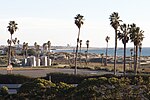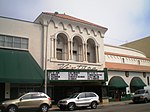Pierpont Inn
1910 establishments in CaliforniaAmerican Craftsman architecture in CaliforniaBuildings and structures in Ventura, CaliforniaBungalow architecture in CaliforniaHistoric Hotels of America ... and 7 more
History of Ventura County, CaliforniaHotels established in 1910Hotels in CaliforniaLandmarks in Ventura, CaliforniaSumner Hunt buildingsTourist attractions in Ventura County, CaliforniaUse mdy dates from May 2023

The Pierpont Inn is a Craftsman bungalow-style hotel in Ventura, California, United States, on a bluff overlooking the Santa Barbara Channel. Built in 1910 for motoring tourists, the complex is City of San Buenaventura Historic Landmark Number 80. Josephine Pierpont thought the site on a bluff overlooking the ocean could serve the increasing number of automobile enthusiasts who would travel along the Pacific Coast looking for a place to rest.
Excerpt from the Wikipedia article Pierpont Inn (License: CC BY-SA 3.0, Authors, Images).Pierpont Inn
Ventura Freeway, Ventura
Geographical coordinates (GPS) Address Nearby Places Show on map
Geographical coordinates (GPS)
| Latitude | Longitude |
|---|---|
| N 34.273333333333 ° | E -119.28333333333 ° |
Address
The Pierpont Inn
Ventura Freeway
93001 Ventura
California, United States
Open on Google Maps










